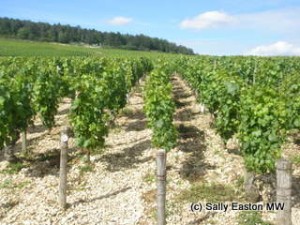Chablis

Prime Chablis vineyards
A version of this article first appeared in Hampshire View, October 2012.
Chablis is the quintessentially steely, floral, stony, flinty, lip-smackingly refreshing wine from the very north of Burgundy. It’s a region firmly ensconced in the cool climate of northerly latitudes.
It happens to be made from chardonnay. But don’t let that put you off. Chardonnay styles have been a-changing for a while the world over, though they’ve stayed pretty constant in Chablis. Out has gone the big, blousy, heavily-oaked, tropical-fruited chardonnays of the 90s and early noughties (often from the new world). In has come restraint, steeliness, stoniness and a firmly refreshing backbone, which cool climate characters and flavour influences Chablis has had all along. (Even Australia is making some great, lean, steely styles of chardonnay now).
Chablis is all about being edgy and nervously excited, creating tension, tautness, and a tingle of expectation tickling down one’s back.
Not only is Chablis the most northerly outpost of Burgundy, it is a sub-region of chardonnay on a particular kind of limestone, which Louis Moreau of Domaine Louis Moreau said gives “finesse, purity, elegance and depth”. The special type of soil, a mix of Upper Jurassic limestone with innumerable small oyster-shell fossils and clay, has long been said to enhance the lean, linear, pure form of Chablis’ wines. This limestone-and-clay-with-oysters soil is named after its English (as well as Chablis) origins – from the village of Kimmeridge, in Dorset. In most other parts of Burgundy, the limestone landscape is older, and doesn’t have the oyster fossils that make the Chablis terroir unique.
And Chablis is not just one thing. There are four levels of Chablis appellation. At the top end, Grand Cru is a different sort of beast, often made in oak barrels and destined for bottle-ageing, but Premier Cru offers an experience that’s a few steps up from village, or ‘straight’ Chablis, and mostly in the same general style – usually unoaked, (and for any that have seen oak it is likely to be unobtrusive/older wood) with the focus on fruit, depth, linearity, a stony, mineral expression. For Moreau, village Chablis is “fresh, citrus and nervous,” in that excited, anticipatory way, while premier cru “brings roundness, depth, weight; a big second layer of quality.”
Given its cool, northerly latitude, vintage variation can be pronounced. Cooler years give steelier fruit, possibly even verging on the austere in youth, and these wines need a bit more time to come around. Vintages such as 2008 and 2010 fall into this classic category. The notable warmer 2009 gave riper, softer (less acidic) fruits, so this is a vintage that is fleshy in youth and can be drunk younger.



